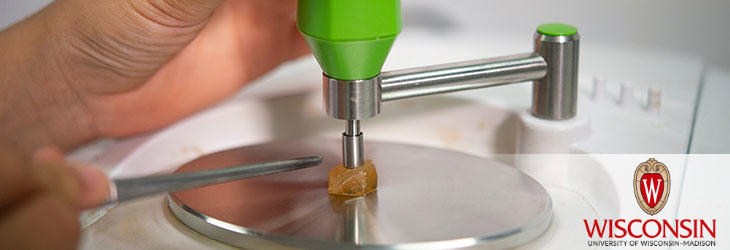Research Tools

New Mass Spectrometry Detector Uses Optically Active Membrane
WARF: P140174US01
Inventors: Robert Blick, Jonathan Rodriguez, Hyunseok Kim, Zlatan Aksamija, Wolfgang Hansen, Christian Heyn
The Wisconsin Alumni Research Foundation (WARF) is seeking commercial partners interested in developing a more sensitive mass spectrometry detector that may be used to detect single proteins or other large molecules.
Overview
Mass spectrometers are analytical instruments that can precisely measure the mass of molecules to determine their composition and identity. Generally, the molecules are ionized and then accelerated by an electrical field. One type of system uses a ‘time of flight’ analyzer in which the relative velocities of different molecular species are determined based on the time it takes them to a reach a detector.
Mass spectrometry is commonly applied to very large molecules such as proteins and other biomolecules. However, sensitivity remains an issue because these molecules have large masses and the difference between their velocities is harder to discern.
As a result, the time of flight measurement must be obtained with higher precision. Conventional detectors are limited by measurement delays that can hide small mass differences between large molecules, which has restricted their use in high level proteomics research.
Mass spectrometry is commonly applied to very large molecules such as proteins and other biomolecules. However, sensitivity remains an issue because these molecules have large masses and the difference between their velocities is harder to discern.
As a result, the time of flight measurement must be obtained with higher precision. Conventional detectors are limited by measurement delays that can hide small mass differences between large molecules, which has restricted their use in high level proteomics research.
The Invention
UW–Madison researchers and collaborators have developed a mass spectrometry detector that is more sensitive to large molecule impacts and may provide better spatial sensitivity. The detector incorporates a thin membrane made of semiconducting materials. The membrane is optically active, converting the kinetic energy of the molecules that strike its front surface into light photons. The photons are detected and converted to an electrical signal by a photosensor.
Applications
- Detection and analysis of molecules with large molecular mass, such as proteins, peptides or DNA
- Could be packaged into MS systems or sold separately
Key Benefits
- Uses photons as a detection intermediary
- More sensitive
- Potential for single ion detection
- Better spatial sensitivity, which is valuable for sector-type mass spectroscopy
- Room temperature light emissions
- Membrane can be fabricated using standard techniques.
- Compatible with time-of-flight mass spectrometry, ion traps, triple quads and Fourier Transform mass spectrometry (FTMS)
Stage of Development
The researchers have integrated the new detector into their existing mass spectrometers.
Additional Information
Related Technologies
Tech Fields
For current licensing status, please contact Jennifer Gottwald at [javascript protected email address] or 608-960-9854